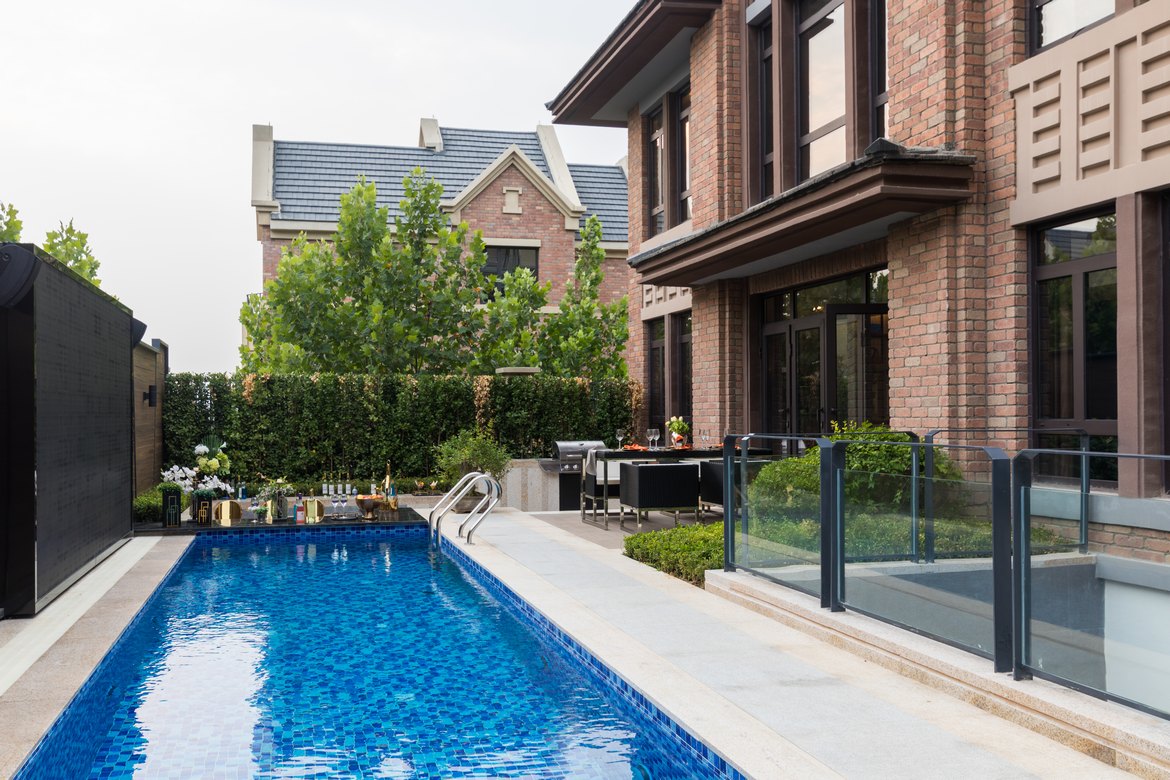環保優勢 environmental protection advantages

本公司壹貫註重空間環境保護的重要性,積極樹立綠色環保的道德觀、職業觀、設計觀。我們從設計之初就註重空間功能、施工工藝及材料使用的環保要求,保證全案環保性,這些表現主要體現在以下三個方面:
1.設計環保
以“可持續發展”作為指導思想,通過對影響室內空間環境質量的化學因素、物理因素、生物因素等的分析,考查和研究新產品;新材料;新技術,了解以上因素的特征,並很好地應用到設計中。
2.工藝環保
建築裝飾裝修工程當中的內容十分繁瑣,涉及到的施工工藝比較多,多工種交集施工情況很常見,因此往往會增加施工工作的難度。為了更好的確保室內裝飾裝修的整體質量問題,提升整體的施工進度,提升空間質量,本公司將綠色環保理念引入室內裝飾裝修的施工過程之中。綠色施工工藝的首要原則是保障施工基本質量以及施工安全,通過科學的管控方式和技術、材料的運用,降低施工過程中的能耗,並且控制因施工帶來的汙染排放量。我們最終的目標是要提高資源的利用率,從而實現有效的循環發展,在裝修過程中體現出綠色、環保、健康。從我們當前的綠色施工工藝技術發展來看,對傳統的施工工藝技術進行改革創新是主要的發展趨勢,我們不斷創新技術,從而提高能源、材料的利用率。
3.材料環保
(1)購進的材料必須符合設計要求。對無機非金屬材料和裝飾材料必須有放射性指標檢測報告。
(2)裝飾工程室內飾面采用的天然大理石、當總面積大於200m2時、應對不同產品分別進行放射性指標的復驗。
(3)所購進的人造木板及飾面板人造木板、必須有遊離甲醛含量或遊離甲醛釋放理檢測報告,如某壹種人造木板或飾面人造木板面積大於500m2時,應對不同產品分別進行遊離甲醛含量或遊離甲醛釋放量的復試。
(4)所采用的水性塗料、水性膠粘劑,水性膠粘劑、水性處理劑必須有總揮發性有機化合物(TVOC)遊離甲醛含量檢測報告;溶劑型塗料、溶劑型塗料、溶劑型膠粘劑必須有總揮發性有機物(TVOC)(聚氨酯烴)含量檢測報告。
(5)裝飾材料的檢測項目不全或對檢測結果有疑問、須將材料送有資格的檢測機構進行檢驗,檢驗合格後方可使用。
(6)選擇供應商前,必須對供應商進行考察:A、產品質量水平、B、生產能力、C、交貨期、D、與本公司合作的業績與信譽(及服務)。然後確定合格的供應商與之簽約。
(7)提供材料需先提供樣品,經項目建設方確認後封樣。質檢員對進場材料的名稱、型號、等級進行檢驗,並檢驗材料外觀質量的運輸過程中有無損壞,檢驗合格後進行驗收記錄,方能批量進場。由材料保管員按”產品標識可追溯性管理程序”的規定進行單獨歸類放置。
(8)主提供的材料由保管員負責做好聯系和安排,質檢員按以上程序檢驗,不合格由材料保管員負責處理。
(9)質檢員對材料進行檢驗,需要時邀請項目建設方或其現場代表壹起參加檢驗。不符合要求的材料,責令退回,決不降級使用。
(10)補充設計或設計變更時,由項目建設方提供材料品種和數量的變更通知,項目經理再組織有關人員按上述程序進行調整。
(11)材料物資存放期間,定期檢查質量,進行維護,並做好記錄和收發臺帳。
The company has always paid attention to the importance of space environmental protection, and actively establish a green environmental ethics, professional concept, design concept. From the beginning of the design, we paid attention to the environmental protection requirements of space function, construction technology and material use to ensure the environmental protection of the whole project. These performances are mainly reflected in the following three aspects:
1. Design environmental protection
With "sustainable development" as the guiding ideology, through the analysis of chemical factors, physical factors and biological factors that affect the quality of indoor space environment, we can examine and study new products, new materials and new technologies, understand the characteristics of the above factors, and apply them to the design well.
2. Process environmental protection
The content of building decoration engineering is very complicated, involving more construction technology, and the intersection of multiple types of work is very common, so it often increases the difficulty of construction work. In order to better ensure the overall quality of interior decoration, improve the overall construction progress and space quality, the company introduces the concept of green environmental protection into the construction process of interior decoration. The primary principle of green construction technology is to ensure the basic quality and safety of construction. Through scientific management and control methods and the use of technology and materials, the energy consumption in the construction process can be reduced, and the pollution emissions caused by construction can be controlled. Our ultimate goal is to improve the utilization rate of resources, so as to achieve effective circular development, and embody green, environmental protection and health in the decoration process. From our current development of green construction technology, the reform and innovation of traditional construction technology is the main development trend. We continue to innovate technology, so as to improve the utilization rate of energy and materials.
3. Environmental protection of materials
(1) The purchased materials must meet the design requirements. For inorganic non-metallic materials and decorative materials, there must be a radioactive index test report.
(2) When the total area of natural marble is more than 200m2, the radioactivity index of different products should be retested.
(3) The purchased wood-based panels and veneer wood-based panels must have free formaldehyde content or free formaldehyde emission detection report. If the area of a certain wood-based panel or veneer wood-based panel is more than 500m2, the free formaldehyde content or free formaldehyde emission of different products should be retested.
(4) The water-based coatings, water-based adhesives, water-based adhesives and water-based treatment agents used must have the test report of total volatile organic compounds (TVOC) free formaldehyde content; the solvent-based coatings, solvent-based coatings and solvent-based adhesives must have the test report of total volatile organic compounds (TVOC) (polyurethane hydrocarbon) content.
(5) If the inspection items of decoration materials are incomplete or there are doubts about the inspection results, the materials must be sent to a qualified inspection organization for inspection, and they can only be used after passing the inspection.
(6) Before selecting a supplier, the supplier must be inspected: A, product quality level, B, production capacity, C, delivery date, D, performance and reputation (and service) of cooperation with the company. Then determine the qualified suppliers and sign the contract with them.
(7) Samples shall be provided before materials are provided and sealed after confirmation by the project owner. The quality inspector shall inspect the name, model and grade of the materials entering the site, and inspect whether the appearance quality of the materials is damaged in the transportation process. After passing the inspection, the acceptance record shall be made before entering the site in batches. The material keeper shall classify and place them separately according to the "product identification traceability management procedure".
(8) The storekeeper shall be responsible for contacting and arranging the materials provided by the owner, the quality inspector shall inspect the materials according to the above procedures, and the unqualified materials shall be handled by the storekeeper.
(9) The quality inspector shall inspect the materials and invite the project owner or its site representative to participate in the inspection when necessary. Materials that do not meet the requirements shall be ordered to be returned and shall never be degraded for use.
(10) In case of supplementary design or design change, the project owner shall provide the change notice of material variety and quantity, and the project manager shall organize relevant personnel to make adjustment according to the above procedures.
(11) During the storage of materials, regularly check the quality, carry out maintenance, and make records and receiving accounts.
The company has always paid attention to the importance of space environmental protection, and actively establish a green environmental ethics, professional concept, design concept. From the beginning of the design, we paid attention to the environmental protection requirements of space function, construction technology and material use to ensure the environmental protection of the whole project. These performances are mainly reflected in the following three aspects:
1. Design environmental protection
With "sustainable development" as the guiding ideology, through the analysis of chemical factors, physical factors and biological factors that affect the quality of indoor space environment, we can examine and study new products, new materials and new technologies, understand the characteristics of the above factors, and apply them to the design well.
2. Process environmental protection
The content of building decoration engineering is very complicated, involving more construction technology, and the intersection of multiple types of work is very common, so it often increases the difficulty of construction work. In order to better ensure the overall quality of interior decoration, improve the overall construction progress and space quality, the company introduces the concept of green environmental protection into the construction process of interior decoration. The primary principle of green construction technology is to ensure the basic quality and safety of construction. Through scientific management and control methods and the use of technology and materials, the energy consumption in the construction process can be reduced, and the pollution emissions caused by construction can be controlled. Our ultimate goal is to improve the utilization rate of resources, so as to achieve effective circular development, and embody green, environmental protection and health in the decoration process. From our current development of green construction technology, the reform and innovation of traditional construction technology is the main development trend. We continue to innovate technology, so as to improve the utilization rate of energy and materials.
3. Environmental protection of materials
(1) The purchased materials must meet the design requirements. For inorganic non-metallic materials and decorative materials, there must be a radioactive index test report.
(2) When the total area of natural marble is more than 200m2, the radioactivity index of different products should be retested.
(3) The purchased wood-based panels and veneer wood-based panels must have free formaldehyde content or free formaldehyde emission detection report. If the area of a certain wood-based panel or veneer wood-based panel is more than 500m2, the free formaldehyde content or free formaldehyde emission of different products should be retested.
(4) The water-based coatings, water-based adhesives, water-based adhesives and water-based treatment agents used must have the test report of total volatile organic compounds (TVOC) free formaldehyde content; the solvent-based coatings, solvent-based coatings and solvent-based adhesives must have the test report of total volatile organic compounds (TVOC) (polyurethane hydrocarbon) content.
(5) If the inspection items of decoration materials are incomplete or there are doubts about the inspection results, the materials must be sent to a qualified inspection organization for inspection, and they can only be used after passing the inspection.
(6) Before selecting a supplier, the supplier must be inspected: A, product quality level, B, production capacity, C, delivery date, D, performance and reputation (and service) of cooperation with the company. Then determine the qualified suppliers and sign the contract with them.
(7) Samples shall be provided before materials are provided and sealed after confirmation by the project owner. The quality inspector shall inspect the name, model and grade of the materials entering the site, and inspect whether the appearance quality of the materials is damaged in the transportation process. After passing the inspection, the acceptance record shall be made before entering the site in batches. The material keeper shall classify and place them separately according to the "product identification traceability management procedure".
(8) The storekeeper shall be responsible for contacting and arranging the materials provided by the owner, the quality inspector shall inspect the materials according to the above procedures, and the unqualified materials shall be handled by the storekeeper.
(9) The quality inspector shall inspect the materials and invite the project owner or its site representative to participate in the inspection when necessary. Materials that do not meet the requirements shall be ordered to be returned and shall never be degraded for use.
(10) In case of supplementary design or design change, the project owner shall provide the change notice of material variety and quantity, and the project manager shall organize relevant personnel to make adjustment according to the above procedures.
(11) During the storage of materials, regularly check the quality, carry out maintenance, and make records and receiving accounts.
